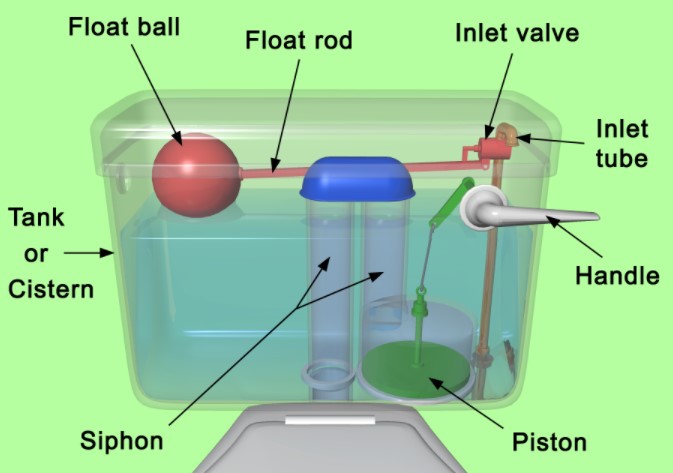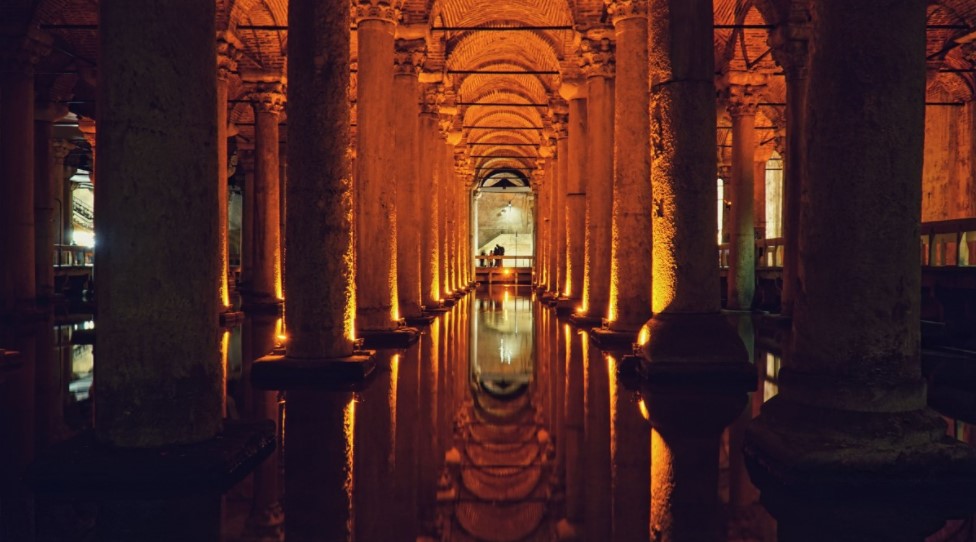Cistern
|
The Basilica Cistern, or Cisterna Basilica, is the largest of several hundred ancient underground cisterns that lie beneath the city of Istanbul, Turkey. It is located near Hagia Sophia and was built in the 6th century during the reign of Byzantine Emperor Justinian I. |
Contents |
[edit] Introduction
According to the Water Supply (Water Fittings) Regulations 1999 (commonly referred to as the Water Fittings Regulations), a cistern ‘means a fixed container for holding water at not greater than atmospheric pressure’.
[edit] History
The earliest examples of cisterns date from the Stone Age. These vessels were frequently used to store water for human consumption and agricultural purposes.
During the Middle Ages, cisterns were primarily used to store water. These were sometimes situated in locations around castles when it was not practical or possible to dig wells.
 This brick water cistern known as the Rye Water House is located on the grounds of St Mary’s churchyard in East Sussex. It dates back to the 1500s and was used by the public for centuries. It is no longer in use but is a scheduled monument and Grade II listed building. This brick water cistern known as the Rye Water House is located on the grounds of St Mary’s churchyard in East Sussex. It dates back to the 1500s and was used by the public for centuries. It is no longer in use but is a scheduled monument and Grade II listed building.
|
Another type of cistern known as a filter cistern was developed during this period. This device collected and enhanced the rain water through a process that both filtered the stored water and enriched it with minerals.
In some instances, ancient underground reservoirs in the form of freshwater subterranean cisterns were used to collect enough water to support entire communities. They served the most important members of society as well as military personnel, ordinary households and farming estates.
|
This circular cistern probably provided drinking water for cattle. |
They were also sometimes used as a type of temporary storage for goods, and in some instances, people and livestock used the underground cisterns as makeshift shelters.
[edit] Modern cisterns
The most commonly found types of domestic cisterns are placed at the top of a dwelling (in an attic, roof space or loft) or situated on ground that is higher than the house. These containers are used to store and deliver water throughout the home.
These household cisterns may not be exclusively supplied by rain water, but instead may be supplied by wells that use electric pumps to transport the water to the cistern. They may also be filled manually with water that has been transported to the location.
[edit] Types of cisterns
The Water Fittings Regulations also define several specific types of cisterns that serve different purposes, including:
- Combined feed and expansion cistern: a cistern for supplying cold water to a hot water system without a separate expansion cistern.
- Expansion cistern (or expansion vessel): a cistern or vessel connected to a water heating system which accommodates the increase in volume of water in the system when the water is heated from cold.
- Storage cistern, which means a cistern for storing water for subsequent use, not being a flushing cistern.
- Flushing cistern: a cistern provided with a valve or device for controlling the discharge of the stored water into a water closet pan or urinal.

|
[edit] Cisterns compared to other water storage methods
[edit] Cistern v water tank
Cisterns are sometimes referred to as water tanks, although the two terms are not interchangeable. A water tank is a closed container while a cistern is a type of water tank that is not entirely closed or sealed. A cistern may be covered with a lid so it can be easily accessed for purposes such as cleaning.
[edit] Cistern v reservoir
Cisterns are frequently used to capture and store rain water for domestic or commercial purposes. A large scale cistern is capable of capturing and retaining thousands of litres of water, much like a reservoir. However, open impounding reservoirs are for the catchment of all types of 'crude' water (unlike cisterns, which are generally used to capture rain water), and service reservoirs are used in water distribution and should be enclosed for protection (unlike cisterns, which are frequently covered, but not enclosed).
[edit] Cistern v well
The difference between modern day cisterns and wells is in the source of the water. Cisterns are commonly supplied by rain water, while the water contained within a well tends to come from groundwater.
[edit] Related articles on Designing Buildings
- Lavatory.
- Macerating toilet systems.
- Rainwater harvesting.
- Reservoir construction.
- Water consumption.
- Water Supply (Water Fittings) Regulations 1999.
- Water tank.
[edit] External resources
Featured articles and news
RTPI leader to become new CIOB Chief Executive Officer
Dr Victoria Hills MRTPI, FICE to take over after Caroline Gumble’s departure.
Social and affordable housing, a long term plan for delivery
The “Delivering a Decade of Renewal for Social and Affordable Housing” strategy sets out future path.
A change to adoptive architecture
Effects of global weather warming on architectural detailing, material choice and human interaction.
The proposed publicly owned and backed subsidiary of Homes England, to facilitate new homes.
How big is the problem and what can we do to mitigate the effects?
Overheating guidance and tools for building designers
A number of cool guides to help with the heat.
The UK's Modern Industrial Strategy: A 10 year plan
Previous consultation criticism, current key elements and general support with some persisting reservations.
Building Safety Regulator reforms
New roles, new staff and a new fast track service pave the way for a single construction regulator.
Architectural Technologist CPDs and Communications
CIAT CPD… and how you can do it!
Cooling centres and cool spaces
Managing extreme heat in cities by directing the public to places for heat stress relief and water sources.
Winter gardens: A brief history and warm variations
Extending the season with glass in different forms and terms.
Restoring Great Yarmouth's Winter Gardens
Transforming one of the least sustainable constructions imaginable.
Construction Skills Mission Board launch sector drive
Newly formed government and industry collaboration set strategy for recruiting an additional 100,000 construction workers a year.
New Architects Code comes into effect in September 2025
ARB Architects Code of Conduct and Practice available with ongoing consultation regarding guidance.
Welsh Skills Body (Medr) launches ambitious plan
The new skills body brings together funding and regulation of tertiary education and research for the devolved nation.
Paul Gandy FCIOB announced as next CIOB President
Former Tilbury Douglas CEO takes helm.
UK Infrastructure: A 10 Year Strategy. In brief with reactions
With the National Infrastructure and Service Transformation Authority (NISTA).
























